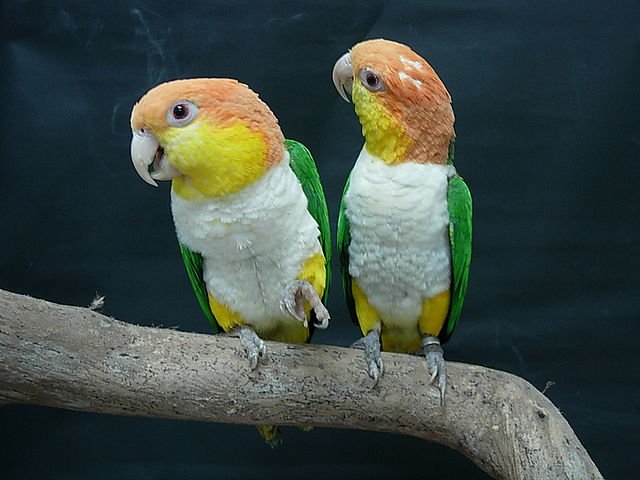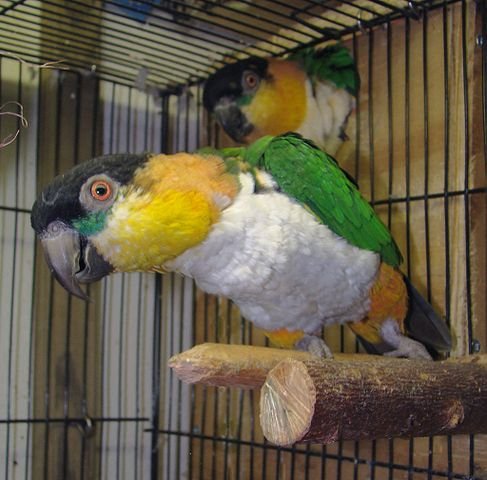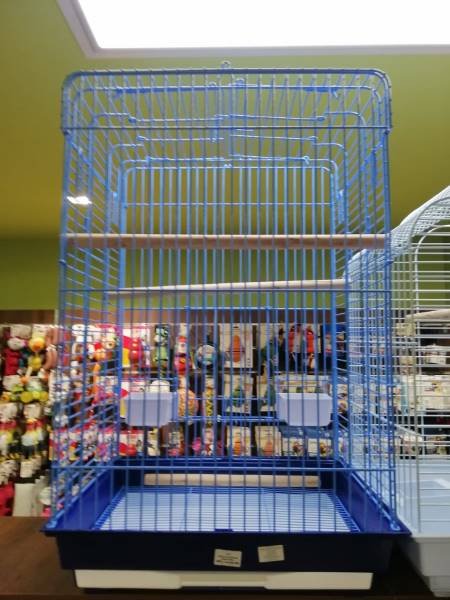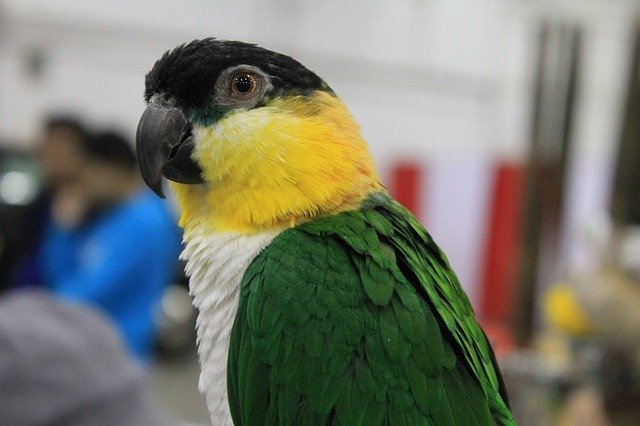Thinking about Caique brings a picture of a colorful bird to mind who is always full of never-ending energy. Calling them playful is a big understatement. They have this uncontained joy of simply being alive and they want to enjoy every moment of their life. This makes them play hard and live harder.
But this enthusiasm sometimes becomes a matter of indiscipline for others around. Throwing tantrums to get their way, demanding attention for fun, and nipping hard in a fit of excitement can quickly become a part of Caiques rather early on. If not arrested at the initial stage, this behavior can take the form of personality. So, for a Caique, training becomes indispensable.
Caique Parrot training
The primary aim of training a Caique is always teaching him the right way. An untrained Caique can ultimately bring trouble for the bird himself. Aggressive, cranky, and territorial are all negative behaviors and can be a cause of unhappiness in Caiques. The only solution to not have them in the first place is training the bird from day one.
But this is not the only advantage of training a Caique. To train his bird, the owner would have to spend some time every day with the bird. This time is very crucial for forming an initial bond with the bird, that serves as a foundation for lifelong companionship. The parrot learns to trust the owner and start counting him as his well-wisher. Lack of this bond makes the bird mistook the owner as a threat.
Once the bird is sure about the fact that his human has no intention to hurt him, he starts listening to him and his instructions. It is the perfect time to teach him the right behavior and discourage the wrong one if any. Additionally, it is the same stage where many owners teach their Caiques some unique tricks to entertain the bird and keep him happy.
Training for Stepping-up
Stepping-up in captivity is similar to perch-hopping in the wild for parrots. The only difference here is that the owner’s finger acts as the perch to hop on. This training is usually one of the first lessons a Caique is taught as it forms the basis of a strong bond between the bird and his human companion. The parrot is encouraged to hop on the index finger of the hand by extending it to the bird. The owner gives him the verbal clue by saying words like ‘step-up’ or ‘come’ or let’s go’. The parrot wouldn’t understand it in the initial training sessions and might even bite the owner hard for being ignorant of his intentions. But patience is the key here until the bird finally hops on the finger. Once learned, the next step is teaching him to hop from one hand to another with similar verbal cues. Keep the practice sessions regular until the bird masters this technique.
Stick Training for rescue
An extension of the ‘step-up’ technique, stick training is an important training lesson that follows the ‘step-up’ lessons. Its importance can be emphasized from the fact that it is extremely useful in case of distress situations like the bird accidentally stuck on a high spot. To rescue the bird from such unreachable danger areas, stick training comes handy. It includes teaching the bird to hop on a long stick by giving him verbal clues like ‘step-up’ or ‘let’s go’. This is followed by bringing the stick downwards on a normal level and making bird hop on the finger/hand safely. Stick training is easier when the bird is already taught stepping up on a finger. He is familiar with the clues and the act then.
Read about gender difference:
https://parrotquaker.com/caique-parrot-gender-difference/
Developing talking abilities
Compared to a few good talkers of the parrot kingdom like African Grey, Caiques happen to lag way behind in their talking abilities. That said, every bird is unique and Caiques are no exception. They happen to be good at mimicking various sounds. But for all parrot lovers, the goal remains to have their parrot talk to them. Caiques can be taught how to speak but that needs a dedicated and patient owner.
The first thing is to start saying out single words to him and using them repeatedly in context. Like saying ‘bye’ while leaving for the office daily. The bird will eventually memorize the word and will relate it to only the situation when the owner leaves home. Do not forget to use the same time always to make it easy for the birds to learn. This way many other words like ‘hello’, ‘thank you’, ‘love you’, can be taught gradually. But keep repeating the previously learned words also.
Same way, Caiques can be taught a few songs or poems by starting from one-liner and making them repeat while having daily chores alongside his cage. Again, keeping the tone of the song uniform every time is the key. Eventually, the bird will follow the suit. Use the same repetition method to help the bird memorize the song.
Training for correcting bad behavior
Another important training technique is meant to discourage bad behavior in Caiques. This includes letting the bird know that his behavior is wrong and will not be entertained. Though it includes scolding the bird and expressing displeasure at his behavior, subtlety is the key during the process. Raising the voice and being overtly aggressive might cause fear in the bird and push him away from the owner forever.
To correct his bad behavior while the bird is at it, make him step-up on the finger and bring him to the eye level. Scold him gently by keeping the voice and tone soft. Emote the displeasure with facial expressions of being disheartened at his behavior. Then, put the bird back in his cage and leave the room for a few minutes. Make sure to return back in some time to play with him to let him know that he has not been abandoned.
Housetraining or Potty training
Training your pet dogs for attending the most primal call of nature is an easy task. But when it comes to parrots, extra efforts are required to be put in for their housetraining. Anticipating the pet Caique’s timing to pass the poop is the first step towards a successful potty training for the bird. Physical and verbal instructions can be used to encourage Caiques for releasing the poop at a specific place like a plate. Over time, the bird starts relating the plate to the activity that it is used for. He will fly to the plate placed in his cage for performing the job every time.
Training for tricks
Caiques are known as the ‘clowns of the bird world’ for their playfulness and mischievous behavior. They are a delight to watch for hours for the level of energy they profuse. With a little dedication, many of their natural behaviors can be turned into interesting tricks. Wing flapping, hopping, and handling toys are some common activities that Caiques perform. These can be combined to create some fascinating performances. Verbal cues can be used to encourage the bird when he indulges in his routine activity. Consistency and positive reinforcement are the keys to train pet Caiques for performing bird tricks.
Caique Intelligence
When parrot’s intelligence is discussed, names like African Grey, Quaker Parrot, crop up. Caiques are never thought in the same context. And it is majorly justified with the fact of them being non-talkers. They can hardly learn more than a few words.
But that does not mean that they lack intelligence. They are intelligent in a different way. Learning to mimic various sounds and remembering them exactly to whistle them out is their forte. They are also great at remembering various environmental sounds like doorbell rings, songs, microwave buzzing, door-creaking, et al and then imitating them with their comical acts.
More about Caique VS other pets here:
https://parrotquaker.com/caique-and-other-parrots/
With their forebrains packing more neurons than other avian species, Caiques possess an intellect enough to give competition to other intelligent parrots like Quaker, etc. For eg., where Quakers can take long hours to crack a foraging toy, Caiques are known to do it under a few minutes only. With Caiques at home, owners always need plenty of such mentally stimulating toys against just a few of these for other parrot species.
Conclusion
Having a Caique at home equals having a little kid on a sugar rush. These birds never have a dull moment. But their boundless energy needs to be channelized and sometimes controlled or their good. And the best way is to train them early on. A trained Caique is fully aware of how to behave and how not to behave while in captivity. He understands his owner better which in turn helps them in forming a loyal and honest bond with their favorite human. This way they are purely fun to have around.





